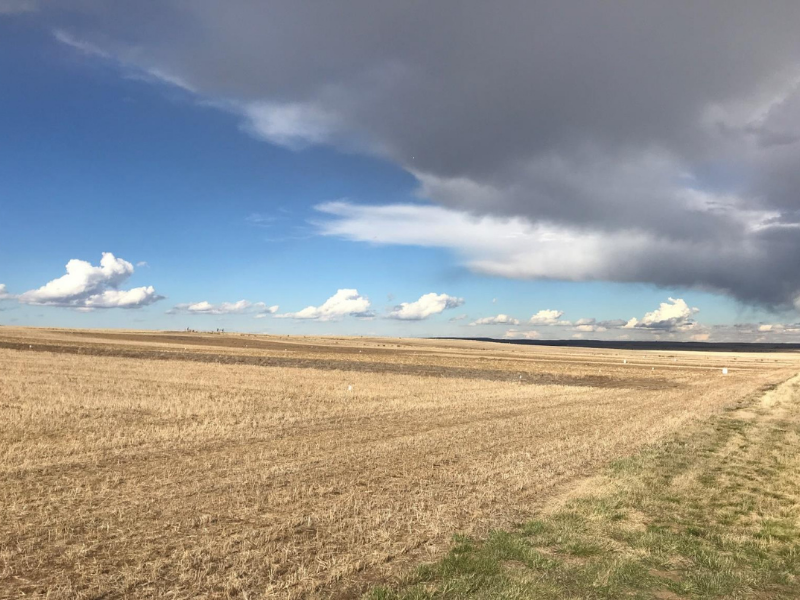
This can be turned into a handy test kit. biologically healthy means a good nutrient balance and good growing conditions and it is best measured indirectly through a test like this.
All good.
Certainly a better solution then sending in soil samples to a lab. Most likley you wouod collect 30 to 100 hundred small samples and put them in hte oven to fully dry out.Then test individually.
Measuring soil health easily and reliably
Carbon dioxide flush information found to be more reliable and useful indicator of soil health
October 20, 2021 - Healthy soils are a precious resource. They are vital for protecting ecosystems, maintaining water quality, producing crops, and mitigating climate change.
There are numerous indicators to measure soil health. However, these indicators don’t always provide consistent results. In a new study, researchers report evaluating a rapid and inexpensive indicator of soil health, especially for dryland farming.
This study was recently published in the Soil Science Society of America Journal, a publication of the Soil Science Society of America.
The researchers measured bursts of carbon dioxide gas emitted when dried soil samples are rewetted. These bursts of carbon dioxide – called carbon dioxide flush – are an indicator of soil microbial activity.
“Measuring carbon dioxide flush is simple and inexpensive,” says Upendra Sainju, lead author of the study. “We also found that carbon dioxide flush is related to several soil properties and long-term crop yields.”
Sainju believes carbon dioxide flush can be used to measure soil health and relate crop yields reliably. Currently, this method is evaluating to estimate dryland crop yields in arid and semiarid regions.
There are several advantages to using carbon dioxide flush as an indicator of soil health. For one, no chemicals are needed. Researchers can measure carbon dioxide flush from soil samples using devices called infrared analyzers.
“Not needing chemicals means carbon dioxide flush can easily be used to measure soil health directly from the field,” says Sainju. “No chemicals being used also makes this process quick and economical.”
That’s important because several existing ways to measure soil health can be expensive and take a long time to analyze. Also, “they provide mixed results when measuring soil health,” says Sainju. Having a single reliable measure of soil health will help farmers, ecologists, policy makers and various other stakeholders to evaluate the sustainability of agroecosystems for crop production, according to Sainju.
In addition to measuring soil health, measuring carbon dioxide flush can also help farmers reduce nitrogen fertilizer use. “We can use carbon dioxide flush to estimate how much nitrogen will be available from the soil to crops during a growing season,” says Sainju. That means farmers can be strategic with fertilizer use. That can lead to lower costs of farming while enhancing environmental benefits.
To test carbon dioxide flush as a soil health indicator, the researchers collected soil samples from two dryland study sites, both in northeastern Montana. For each soil sample, Sainju and colleagues measured carbon dioxide flush in two different ways.
One was the traditional way – add water to air-dried soil samples and let them sit for four days. Then the researchers used chemicals to measure carbon dioxide flush.
They also tested a faster method; one where the wetted soils sat for just one day. Then, the researchers used an infrared gas analyzer to detect the carbon dioxide flush from the samples.
These two methods yielded slightly different carbon dioxide flush results.
So, Sainju and colleagues tested a whole lot of soil properties – physical, chemical, and biological – and matched them with the two sets of carbon dioxide flush results. “Our results showed that the one-day results were better related to soil properties and crop yields than the four-day incubations,” says Sainju. That meant the easier and faster method of measuring carbon dioxide flush also resulted in a more reliable, inexpensive, and useful indicator of soil health.
Sainju and colleagues plan to test this method in short-term experiments under dryland and irrigated cropping systems next. They will also expand testing the method in various soil and climatic conditions in different regions of the country.
Testing of carbon dioxide flush as a predictor of long-term mean crop yields is especially important, according to the study authors. That’s because non-soil factors – such as droughts and floods, or pests – can affect crop production dramatically in some years. In the meantime, “measuring carbon dioxide flush provides soil health results that are accurate and reliable,” says Sainju.
Photo Caption: A view of the experimental site in dryland farming in eastern Montana where soil samples were collected to measure carbon dioxide flush. The research team determined that the easier and faster method of measuring carbon dioxide flush also resulted in a more reliable and useful indicator of soil health. Credit: Daniel Liptzin
High-resolution images for use with this story only available by contacting Caitlin Heitman, cheitman@sciencesocieties.org.
No comments:
Post a Comment